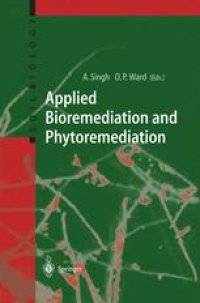
Ebook: Applied Bioremediation and Phytoremediation
- Tags: Soil Science & Conservation, Terrestrial Pollution, Applied Microbiology, Microbiology, Ecotoxicology
- Series: Soil Biology 1
- Year: 2004
- Publisher: Springer-Verlag Berlin Heidelberg
- Edition: 1
- Language: English
- pdf
The production of a vast array of chemicals, especially petroleum compounds during the last century, has caused a serious deterioration in environmental quality. In this context, one major threat is posed by the continually expanding areas of contaminated soils and sediments.
Biotechnological methods based on the biodegradation of environmental pollutants or phytoremediation of persistent organic contaminants and metals are being developed. Bioremediation has now been used successfully to remediate many petroleum-contaminated sites. However, there are as yet no commercial technologies commonly used to remediate the most recalcitrant contaminants, such as explosives, pesticides and metallic pollutants. Nevertheless, bioremediation is a rapidly advancing field and new bio-based remedial technologies are continuing to emerge. For this volume, a number of experts from universities, government laboratories and industry, have contributed chapters on innovative methods in bioremediation and phytoremediation.
The production of a vast array of chemicals, especially petroleum compounds during the last century, has caused a serious deterioration in environmental quality. In this context, one major threat is posed by the continually expanding areas of contaminated soils and sediments.
Biotechnological methods based on the biodegradation of environmental pollutants or phytoremediation of persistent organic contaminants and metals are being developed. Bioremediation has now been used successfully to remediate many petroleum-contaminated sites. However, there are as yet no commercial technologies commonly used to remediate the most recalcitrant contaminants, such as explosives, pesticides and metallic pollutants. Nevertheless, bioremediation is a rapidly advancing field and new bio-based remedial technologies are continuing to emerge. For this volume, a number of experts from universities, government laboratories and industry, have contributed chapters on innovative methods in bioremediation and phytoremediation.
The production of a vast array of chemicals, especially petroleum compounds during the last century, has caused a serious deterioration in environmental quality. In this context, one major threat is posed by the continually expanding areas of contaminated soils and sediments.
Biotechnological methods based on the biodegradation of environmental pollutants or phytoremediation of persistent organic contaminants and metals are being developed. Bioremediation has now been used successfully to remediate many petroleum-contaminated sites. However, there are as yet no commercial technologies commonly used to remediate the most recalcitrant contaminants, such as explosives, pesticides and metallic pollutants. Nevertheless, bioremediation is a rapidly advancing field and new bio-based remedial technologies are continuing to emerge. For this volume, a number of experts from universities, government laboratories and industry, have contributed chapters on innovative methods in bioremediation and phytoremediation.
Content:
Front Matter....Pages I-XIX
Soil Bioremediation and Phytoremediation — An Overview....Pages 1-12
Biodegradation and Bioremediation of Petroleum Pollutants in Soil....Pages 13-34
Bioremediation of Pesticide-Contaminated Soils....Pages 35-54
Biodegradation and Bioremediation of Explosives....Pages 55-80
Biological Treatment of Metallic Pollutants....Pages 81-113
Phytoremediation of Persistent Organic Contaminants in the Environment....Pages 115-134
Phytoremediation of Metals and Inorganic Pollutants....Pages 135-157
Remediation of Organic Pollutants Through Natural Attenuation....Pages 159-186
Evaluation of Current Soil Bioremediation Technologies....Pages 187-214
Bioremediation of Petroleum Hydrocarbon-Polluted Soils in Extreme Temperature Environments....Pages 215-234
Innovative Methods in Biofiltration of Air Contaminants....Pages 235-253
Risk-Based Remediation of Contaminated Soil....Pages 255-275
Back Matter....Pages 277-281
The production of a vast array of chemicals, especially petroleum compounds during the last century, has caused a serious deterioration in environmental quality. In this context, one major threat is posed by the continually expanding areas of contaminated soils and sediments.
Biotechnological methods based on the biodegradation of environmental pollutants or phytoremediation of persistent organic contaminants and metals are being developed. Bioremediation has now been used successfully to remediate many petroleum-contaminated sites. However, there are as yet no commercial technologies commonly used to remediate the most recalcitrant contaminants, such as explosives, pesticides and metallic pollutants. Nevertheless, bioremediation is a rapidly advancing field and new bio-based remedial technologies are continuing to emerge. For this volume, a number of experts from universities, government laboratories and industry, have contributed chapters on innovative methods in bioremediation and phytoremediation.
Content:
Front Matter....Pages I-XIX
Soil Bioremediation and Phytoremediation — An Overview....Pages 1-12
Biodegradation and Bioremediation of Petroleum Pollutants in Soil....Pages 13-34
Bioremediation of Pesticide-Contaminated Soils....Pages 35-54
Biodegradation and Bioremediation of Explosives....Pages 55-80
Biological Treatment of Metallic Pollutants....Pages 81-113
Phytoremediation of Persistent Organic Contaminants in the Environment....Pages 115-134
Phytoremediation of Metals and Inorganic Pollutants....Pages 135-157
Remediation of Organic Pollutants Through Natural Attenuation....Pages 159-186
Evaluation of Current Soil Bioremediation Technologies....Pages 187-214
Bioremediation of Petroleum Hydrocarbon-Polluted Soils in Extreme Temperature Environments....Pages 215-234
Innovative Methods in Biofiltration of Air Contaminants....Pages 235-253
Risk-Based Remediation of Contaminated Soil....Pages 255-275
Back Matter....Pages 277-281
....